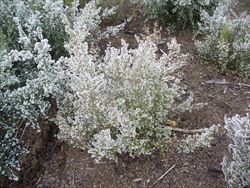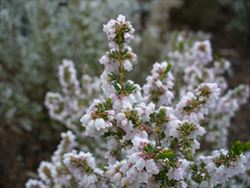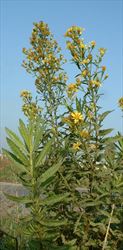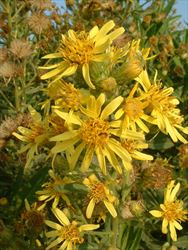Click on images to enlarge

Kirstenbosch Gardens Cape Town, By Andrew massyn (Own work) [Public domain], via Wikimedia Commons

By Andrew massyn (Own work) [Public domain], via Wikimedia Commons

Photo by: Rick Jpelleg - wikipedia.org

Photo by: Rick Jpelleg - wikipedia.org

Photo by: Rick Jpelleg - wikipedia.org

Photo by: Rick Jpelleg - wikipedia.org
Scientific Name
Dittrichia viscosa (L.) Greuter
Synonyms
Inula viscosa (L.) Ait.
Family
Asteraceae (Queensland, New South Wales, the ACT, Victoria, Tasmania, Western Australia and the Northern Territory)Compositae (South Australia)
Common Names
false yellow head, false yellowhead, sticky fleabane, yellow-flowered stinkwort
Origin
Native to southern Europe (i.e. Albania, Bulgaria, Greece, Italy, Yugoslavia, France, Portugal and Spain), the Madeira Islands, the Canary Islands, northern Africa (i.e. Algeria, Egypt, Libya, Morocco and Tunisia) and western Asia.
Cultivation
It is not certain how false yellowhead was introduced to Australia, but it may have escaped from cultivation as a garden ornamental.
Naturalised Distribution
Naturalised in the coastal districts of south-western Western Australia. It has spread from its initial site of naturalisation at Albany to Mount Barker and Denmark. There are also populations at Walpole-Peaceful Bay and Mount Manypeaks, and an isolated population has also been recorded on a train track at Yarloop.
Also naturalised in a few locations in the UK and the USA.
Habitat
It usually grows in highly disturbed areas (e.g. along roadsides, railway lines, fire breaks and walking trails) in temperate regions, but it is occasionally also found in swamps and along waterways.
Habit
An upright (i.e. erect) and long-lived (i.e. perennial) small shrub usually growing 0.3-1.5 m tall and about 1 m across.
Distinguishing Features
- a small upright shrub (0.3-1.5 m tall).
- its younger stems and leaves are covered with sticky hairs which exude a foul-smelling oil.
- its greyish-green leaves (25-100 mm long and 8-18 mm wide) are stalkless with stem-clasping bases.
- its yellow flower-heads (10-22 mm across) are daisy-like with 12-18 'petals' (i.e. ray florets).
- its light brown 'seeds' (about 2 mm long) are topped with a ring of about 15-25 bristles (about 5 mm long).
Stems and Leaves
The younger stems and leaves are covered with sticky (i.e. glandular) hairs which exude a sticky, foul-smelling, oil. The older stems become thick and woody towards the base of the plant and turn brown in colour as they mature.
The greyish-green leaves (25-100 mm long and 8-18 mm wide) are alternately arranged along the stems. They are stalkless (i.e. sessile) with stem-clasping bases and pointed tips (i.e. apices). These leaves are lance-shaped (i.e. lanceolate) to oval in shape (i.e. elliptic) and have toothed (i.e. serrated) margins.
Flowers and Fruit
The yellow flower-heads (i.e. capitula) are daisy-like with numerous (12-18) radiating 'petals' (i.e. ray florets). These flower-heads (10-22 mm across) are surrounded by four or five rows (i.e. an involucre) of numerous (30-40) narrow, triangular, sticky bracts (3-9 mm long) at the base. The bright yellow 'petals' (i.e. ray florets) are 10-12 mm long and at the centre of the flower-head are numerous (about 36) tiny yellow flowers (i.e. tubular or disc florets). Several hundred of these flower-heads can be produced in branched clusters towards the tips of the stems (i.e. in terminal panicles). Flowering occurs during summer and autumn (i.e. from December to May).
The light brown 'seeds' (i.e. achenes) are approximately 2 mm long and topped with a ring (i.e. pappus) of about 15-25 whitish bristles (about 5 mm long).
Reproduction and Dispersal
False yellowhead (Dittrichia viscosa) reproduces by seed, which are commonly dispersed by wind and water. They can also be spread during soil movement (e.g. during road construction and maintenance) or by vehicles and machinery.
Environmental Impact
False yellowhead (Dittrichia viscosa) is regarded as an environmental weed in Western Australia and as a potential environmental weed in some other states. This species is on the Alert List for Environmental Weeds, a list of 28 introduced plants that are currently not very widespread but are considered to pose a significant threat to Australia's environment.
False yellowhead (Dittrichia viscosa) is thought to have the potential to be a serious environmental weed, particularly in southwestern Western Australia and areas of similar climate in southern and eastern Australia. In south-western Western Australia it has already invaded the Mt Adelaide and Mt Clarence Reserve in Albany, where it has spread from roadsides and walking trails into relatively undisturbed bushland.
Other Impacts
False yellowhead (Dittrichia viscosa) can cause health problems in humans and animals. The sticky oil produced by the leaves and stems causes contact dermatitis, resulting in itching and blistering of the skin. It is also known to release substances that inhibit the germination of nearby plants and is toxic to livestock. Dense infestations may also reduce the productivity of pastures and the aesthetic appeal of tourist areas.
Legislation
This species is declared under legislation in the following states and territories:
- Tasmania: D - the importation or sale of this species is prohibited and measures to reduce its population in an area, eradicate it from an area, or restrict it to a particular area may be required.
- Western Australia: Unassessed - this species is declared in other states or territories and is prohibited until assessed via a weed risk assessment (throughout the entire state).
Similar Species
False yellowhead (Dittrichia viscosa) is very similar to stinkwort (Dittrichia graveolens) and telegraph weed (Heterotheca grandiflora), and is also relatively similar to the fleabanes (Conyza spp.). These species can be distinguished by the following differences:
- false yellowhead (Dittrichia viscosa ) is a spreading long-lived (i.e. perennial) shrub (0.3-1.5 m tall) with younger stems, leaves and flower-head bracts that are covered in sticky (i.e. glandular) hairs. Its relatively large flower-heads (10-22 mm across) have several to many (12-18) relatively large yellow 'petals' (i.e. ray florets) 10-12 mm long.
- stinkwort (Dittrichia graveolens ) is an upright short-lived (i.e. annual) herbaceous plant (growing up to 1 m tall) with younger stems, leaves and flower-head bracts that are covered in sticky (i.e. glandular) hairs. Its relatively small flower-heads (3-10 mm across) have several (10-12) relatively small yellow 'petals' (i.e. ray florets) 4-7 mm long.
- telegraph weed (Heterotheca grandiflora) is an upright short-lived (i.e. annual) herbaceous plant (growing up to 2 m tall) with younger stems, leaves and flower-head bracts that are covered in hairs (though they are only sometimes glandular). Its relatively large flower-heads (15-22 mm across) have many (25-35) relatively small yellow 'petals' (i.e. ray florets) 5-8 mm long.
- the fleabanes (Conyza spp.) are upright short-lived (i.e. annual) herbaceous plants (growing up to 2 m tall) but their stems, leaves and flower-heads are not covered in sticky (i.e. glandular) hairs (though they may be hairy). Their relatively small flower-heads (usually less than 5 mm across) do not have any obvious 'petals' (i.e. ray florets), although some may have tiny white 'petals' (i.e. ray florets) about 1 mm long.

